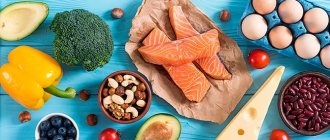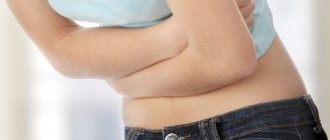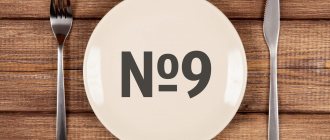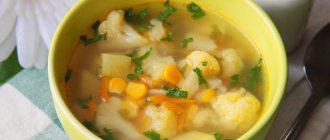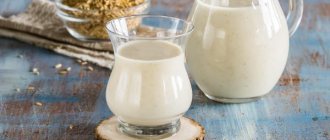Diet No. 3 is a special nutrition program developed by the famous Soviet scientist, gastroenterologist-nutritionist Manuil Pevzner. This therapeutic diet is prescribed for chronic intestinal diseases accompanied by constipation. Problems with regular bowel movements are quite common, most often caused by poor diet, sedentary lifestyle and poor quality food. Most working people, as well as students, are exposed to all these factors. Also, diet No. 3 is often prescribed to older people, since intestinal motility worsens with age.
Chronic, prolonged constipation leads to serious complications such as colitis and rectal diseases. The third diet according to Pevzner will prevent these consequences in time. Read more about the diet, what you can eat, how to cook and how to finally return to the regular menu.
General characteristics of dietary table No. 3
Diet No. 3 fully satisfies a person’s physiological needs for energy and nutrients.
It provides stimulation of peristalsis through the inclusion of mechanical and temperature stimuli in the diet. Fiber-rich foods are recommended. The diet includes an abundance of plant fiber, mainly in the form of salads from fresh vegetables, grated on a coarse grater.
Products that provoke fermentation processes in the intestines, as well as fatty and fried foods that negatively affect other organs of the digestive system are excluded from the diet.
Diet No. 3 provides for fractional meals 4-6 times a day, at the same time, without long breaks between meals. Food is prepared uncut, preferably boiling, baking or steaming. It is recommended to drink cold water or juice on an empty stomach, and fermented milk drinks and dried fruit compotes at night.
Recipes for the table No. 3
Be sure to eat liquid food once a day. Soups are prepared from a whole piece of meat in a second broth; it is also good to use borscht and various cold soups in the menu. It is better to give preference to vegetable decoctions. Let's consider a complex version of cold vegetable soup and several unusual recipes from ordinary products.
Dietary beetroot
Have to take:
- 2 medium boiled beets;
- a slice of lemon;
- 0.5 liters of low-fat kefir;
- 1 tbsp. l. Sahara;
- chopped parsley and dill.
One beet should be cut into cubes, and the second should be grated on a fine or coarse grater. Squeeze the juice out of the grated one. Also cut the lemon into small pieces. Place beet cubes and lemon in a plate, sprinkle with sugar, pour kefir and beet juice on top. Add greens and stir. Keep the finished soup in the refrigerator.
Carrot jelly
Have to take:
- 100 g carrots;
- 50 g sugar;
- 10 g gelatin;
- citric acid.
Peeled carrots should be cut into arbitrary cubes or strips and cooked until fully cooked. Then pour half of the water into a separate container, pour sugar and citric acid into it, and bring to a boil. Grind the carrots with the remaining broth until smooth. Mix syrup, carrot mass and prepared gelatin. Divide the jelly into portions and cool in the refrigerator.
Diet mayonnaise
Have to take:
- 1 egg yolk;
- 50 ml vegetable oil;
- 1 tsp. sugar or substitute;
- 2 tsp. citric acid solution.
Beat the yolk with sugar or xylitol, slowly adding vegetable oil. When the mass becomes thick and homogeneous, you need to add citric acid to it and mix everything. This sauce is also suitable for diabetes.
To make it easier to create your therapeutic diet, consider a sample menu for a week for diet number three.
Chemical composition and energy value of dietary table No. 3
Proteins: 90–100 g (45% animal proteins). Fats: 80–90 g (30% vegetable fats). Carbohydrates: 350–400 g (no more than 40 g of simple carbohydrates). Daily calorie content: 2,300 – 2,500 kcal. Free liquid: 1.5–2 l. Table salt: 8–10 g. Vitamins: retinol (A) – 2 mg, riboflavin (B2) – 4 mg, thiamine (B1) – 4 mg, nicotinic acid (B3) – 30 mg, ascorbic acid (C) – 100 mg. Macroelements: calcium 0.8 g, magnesium 0.5 g, phosphorus 1.2 g. Microelements: iron – 15 mg. Optimal food temperature: 15–65 degrees Celsius.
Nutritional Features
To obtain the necessary therapeutic results of Diet 3, it is important to pay attention to several nutritional features, which include:
- The list of permitted food products is quite wide. It mainly includes foods that stimulate intestinal motility and also moderately increase the functional activity of the digestive glands.
- It is recommended to eat small meals frequently (4 to 6 times a day).
- The last meal should be no earlier than 2 hours before expected sleep (gastroenterologists recommend having dinner 3-4 hours before bedtime).
- The diet is not gentle, so there is no need to chop food before eating. However, for better absorption of food ingredients, it is advisable to chew them thoroughly before swallowing food. Also, the temperature of prepared foods can vary over a fairly wide range, with the exception of very cold or very hot food.
Recommended products and dishes of the diet table No. 3
Bread: from wholemeal flour, rye, grain, with bran. Cookies and other baked goods are allowed, with the exception of fresh bread made from fine wheat flour. Soups: vegetable soups (borscht, cabbage soup, minestrone, etc.), cold soups, pearl barley soup in weak meat or fish broth. Meat dishes: boiled, baked, fried without crust, in one piece or in the form of cutlets, prepared from beef, veal, chicken, turkey, rabbit. Fish dishes: boiled or baked low-fat fish in pieces or in the form of cutlets, seafood is recommended. Side dishes: crumbly porridge from cereals (rice, pasta - limited), vegetables in any form (cabbage - if tolerated, potatoes and legumes - limited), beets, carrots, zucchini, cauliflower, pumpkin, tomatoes, cucumbers, lettuce are preferred . Porridges: crumbly porridges and casseroles. Dairy products: sour cream and milk in dishes, mild cheese, cottage cheese (fresh or in dishes), fermented milk drinks. Eggs: no more than 1 pc. per day (steam omelet, soft-boiled or as part of dishes). Appetizers: vegetable salads and vinaigrettes, fruit salads, vegetable caviar, sauerkraut, soaked herring, aspic, cheeses. Sauces, spices: bechamel, mild sauces with meat broth, tomato sauce, and occasionally sour cream sauce. Cinnamon, vanilla, bay leaf, chopped fresh herbs (dill, celery, parsley). Sweet dishes: fresh and baked fruits in large quantities are especially recommended. Plums, figs, melon, apricots (including dried apricots), prunes, preserves, mousses, jams, marshmallows, and marmalade are desirable. Drinks: tea and coffee substitutes, fresh juices (cold), rosehip infusion, bran infusion. Fats: unsalted butter, refined vegetable oils (olive, corn).
How to create a menu?
The basic rules to follow when creating a menu are as follows:
- nutrition should be complete and balanced;
- the content of dietary fiber must be increased through traditional sources - cereals, local vegetables and fruits, avoiding exotic foods that can irritate the gastrointestinal mucosa;
- for persistent constipation, emphasis should be placed on plant foods;
- if there are no medical contraindications, then you must definitely consume fermented milk products;
Table 3 (for constipation) diet. Sample Menu - exclude, if possible, foods that slow down intestinal motility;
- It is better to replace sweets with fruits and dried fruits; you should also limit the consumption of honey;
- for diseases of the small intestine, you need to increase the amount of protein foods.
Excluded foods and dishes of the diet table No. 3
Dishes rich in extractive substances (strong broths), essential oils, spicy seasonings, smoked foods, and alcoholic beverages are excluded from the diet. You should avoid foods that cause fermentation processes in the intestines.
Excluded are fresh wheat bread, products made from butter and puff pastry, rice, semolina, vermicelli (pasta - limited), hot food, viscous porridges, jelly, fatty meat, canned food, marinades, carbonated drinks (including kvass), fried eggs, hard-boiled eggs.
Also exclude sharp cheeses, sorrel, onions, spinach, turnips, radishes, radishes, garlic, chocolate and fatty pastry creams. You should not consume cooking fats, blueberries, quince, dogwood, cocoa, coffee, hot sauces and seasonings.
For children
The most common cause of constipation in children is the functional characteristics of the intestine - a slowdown in its peristalsis, which helps push through feces. They, accumulating in the large intestine, gradually expand and lengthen it, causing functional megacolon (large colon).
With constipation, it becomes difficult for a child to defecate outside the home, and he suppresses the urge. This creates a vicious circle that makes the situation worse. Therefore, by any means necessary, you need to achieve daily independent bowel movements and develop the habit of emptying your bowels in the morning.
Prune drink
Prevention of chronic constipation begins in infancy, when complementary feeding begins. Vegetable and fruit purees (apple, plum), a variety of cereals, grated beets and beet juice, and zucchini should be introduced into the diet in a timely manner. It is no longer possible to force a grown-up child to eat a serving of salad or boiled beets; many also refuse to eat prunes, not to mention drinking a spoonful of vegetable oil on an empty stomach. Therefore, you need to proceed from what is more acceptable for the child and feasible.
In addition to the generally accepted diet, during the day you need to include foods that stimulate peristalsis:
- On an empty stomach, give a cold sweet drink - rosehip infusion, water with honey, prune infusion.
- During the day, as a snack, offer vegetable and fruit juices, vegetable decoctions, prune decoction, carrot and beet puree. If it is difficult to give them to your child, try mixing in grated apple, chopped plums or sweet berries and fruits that your child likes. He might like a puree of boiled dried fruits, which can be served with ice cream or whipped egg whites (cream).
- It must be remembered that the same product can have the opposite effect. Thus, raw apple purees have a strengthening effect, and whole apples with skin, on the contrary, accelerate bowel movements. Fat (5-10 g) in free form has a laxative effect, and the same amount of it in dishes, distributed throughout the day at all meals, has little effect on peristalsis.
A change in the composition of the intestinal microflora causes constipation, and given that children often get sick and are prescribed antibiotics , this only makes the situation worse. Fermented milk drinks - live yoghurts and acidophilic products - will help normalize the intestinal microflora. Learn to make kefir with bifidobacteria , and you will always have “one-day” kefir - this is what you should take for constipation.
If a child experiences increased fermentation in the intestines, it must be taken into account that it is caused by excess carbohydrates and foods high in dietary fiber if they are consumed raw and not boiled and mashed. These processes can be influenced by changing the technology for preparing vegetable dishes.
It is of great importance to adhere to the eating regimen, which contributes to the smooth functioning of the intestines. In this regard, children attending preschool institutions are in an advantageous position. Increasing mobility of the child, proper nutrition and regular meals most often eliminate constipation. But if all the measures you have taken have been exhausted, contact a pediatric proctologist.
Sample diet menu No. 3
On an empty stomach: cold decoction of prunes. First breakfast: squash caviar, cottage cheese, bread, weak tea. Second breakfast: curdled milk, baked apple, bread, rose hip decoction. Lunch: aspic, vegetarian cabbage soup, stewed chicken with boiled vegetables, compote. Dinner: buckwheat casserole, cutlet with stewed cabbage, fresh fruit, bran decoction, jam, bread. At night: kefir, soaked dried fruits.
Sources:
- Order of the Ministry of Health of the Russian Federation No. 330 “On measures to improve clinical nutrition in medical institutions of the Russian Federation” dated 05.08.2003
When diet number 3 is a necessity
Gentle nutrition is an integral part of the course of treatment of any diseases of the gastrointestinal tract. One of the most common and unpleasant symptoms that one has to deal with when there is a disruption in the functioning of the gastrointestinal tract is constipation. Pain and discomfort negatively affect the functioning of the body and the quality of life in general. Eating the right foods, coupled with drug therapy, helps to quickly restore motor skills and improve well-being.
In addition to irregular bowel movements, table number 3 helps to cope with other problems caused by difficulties during bowel movements. It can also be prescribed to relieve hemorrhoids and disorders of the integrity of the anal mucosa.
Meat casserole
- Salt 300 g minced meat
- add 2 egg whites and a little milk
- mix everything thoroughly and place on a greased baking sheet
- top the minced meat with grated carrots and steam
- After cooking is complete, brush the casserole with sour cream.
As a result of using the third dietary table , intestinal function gradually improves, its peristalsis is normalized, gas formation is reduced and stable stools are restored. In addition, switching to this form of nutrition is quite easy due to the wide variety of dishes and the availability of all ingredients.
Authorized Products
You can eat dried and yesterday's bread, you can eat multi-grain breads with bran. Dry cookies are acceptable, but not made from butter dough. Light soups are allowed as first courses, especially with vegetables. You can use broths, but not very rich ones. Soft-boiled eggs are allowed, but no more than 2 eggs per day.
Porridges include buckwheat and oatmeal. You can make puddings and souffles from them. It is allowed to eat any meat, but low-fat varieties. The same rule should be followed with fish. You can make cutlets, meatballs, souffles, meatballs, and chopped dishes from meat and fish.
There are also few restrictions on vegetables; only those that can cause bloating and contain a lot of oxalic acid are prohibited. You can consume up to 800 g of salad per day.
Apples will be useful, it is better to bake them, cherries, strawberries, apricots, currants and others. You can even have bananas, but no more than 3 throughout the week. It is recommended to make compotes and juices from berries and fruits.
Milk is allowed only on the condition that it will act as a component of a certain dish, but there should not be more than 50 g of it per day. Fermented milk products are allowed, but with a fat content of no more than 20%. Non-acidic cottage cheese can be consumed. You can have mild cheese about 2 times a week, in small quantities, up to 40 g.
It is permissible to consume 20 g of butter, vegetable oils are allowed.
Sweets are not prohibited, in particular dried fruits, jam, marmalade, honey and marshmallows.
There are practically no restrictions regarding drinks. Mineral water is drunk without gas, and its composition must be determined by a doctor.
Sample menu for the week
Monday
- Tomorrow - lazy dumplings with sour cream, green tea.
- Lunch – baked apple.
- Lunch – soup with vegetables, steamed chicken fillet, dried fruit compote.
- Afternoon snack – fruit yoghurt.
- Dinner – barley porridge with boiled beef meatballs, fermented baked milk.
Tuesday
- Breakfast - egg white omelet, boiled beets in the form of a salad with sunflower oil, chicory drink.
- Lunch – fruit salad topped with yogurt.
- Lunch – buckwheat soup, including potatoes and cooked in low-fat chicken broth, vegetable salad with the addition of hard cheese, jelly.
- Afternoon snack – salad including fresh apple and carrots.
- Dinner – mashed cauliflower, steamed veal, compote.
Wednesday
- Breakfast - steamed chicken egg omelet with the addition of hard cheese, weak black tea.
- Lunch – puree made from apples.
- Lunch – vegetable borscht, boiled beef tongue, tomato juice.
- Afternoon snack – honey with a bun and rosehip infusion.
- Dinner – boiled buckwheat, boneless fish stew, fermented baked milk.
Thursday
- Breakfast - vegetable salad with vegetable oil, barley drink.
- Lunch – rosehip decoction, biscuits.
- Lunch - cabbage soup, stew with vegetables and meat, green tea with jam.
- Afternoon snack – fresh fruit.
- Dinner – steamed boneless fish, barley porridge boiled in water, kefir.
Friday
- Breakfast - soft-boiled chicken egg, wheat porridge, weak black tea with milk.
- Lunch - fermented baked milk.
- Lunch – soup with beef meatballs, vinaigrette, dried fruit compote.
- Afternoon snack – cottage cheese with fruit, seasoned with sour cream.
- Dinner – mashed potatoes with steamed fish cutlets, kefir.
Saturday
- Breakfast - barley porridge cooked in milk with the addition of prunes and dried apricots, green tea.
- Lunch – fruit yoghurt.
- Lunch – low-fat fish broth with potatoes and herbs, boiled vegetables with fish, apple compote.
- Afternoon snack – baked apple.
- Dinner – cabbage rolls with vegetables, vegetable salad with vegetable oil, chicory drink.
Sunday
- Breakfast - cheesecakes, seasoned with sour cream and jam, weak black tea.
- Lunch – fruit puree.
- Lunch – vegetable cabbage soup, jellied beef, berry compote.
- Afternoon snack – fruit salad topped with yogurt.
- Dinner – vegetable stew, steamed chicken meatballs, kefir.
Doctor's opinion
Therapeutic diet 3 was developed by physician Pevzner. It has been used in clinical practice for a long time and has shown good therapeutic results in the treatment of chronic constipation, associated primarily with functional disorders of the digestive system. Within a few weeks after starting to use Diet 3, there was an improvement in the person’s general condition and normalization of stool, which was usually noted once a day. The recommendations can also be applied to children with functional constipation, which is often of hereditary origin. If pregnant women develop constipation, it is not recommended to use dietary recommendations on their own. You should first consult with a doctor who will determine the cause of functional disorders and also individually select the most optimal diet, taking into account the increased needs of the body.
